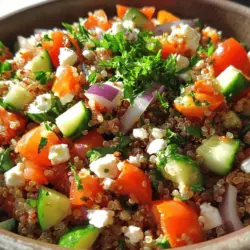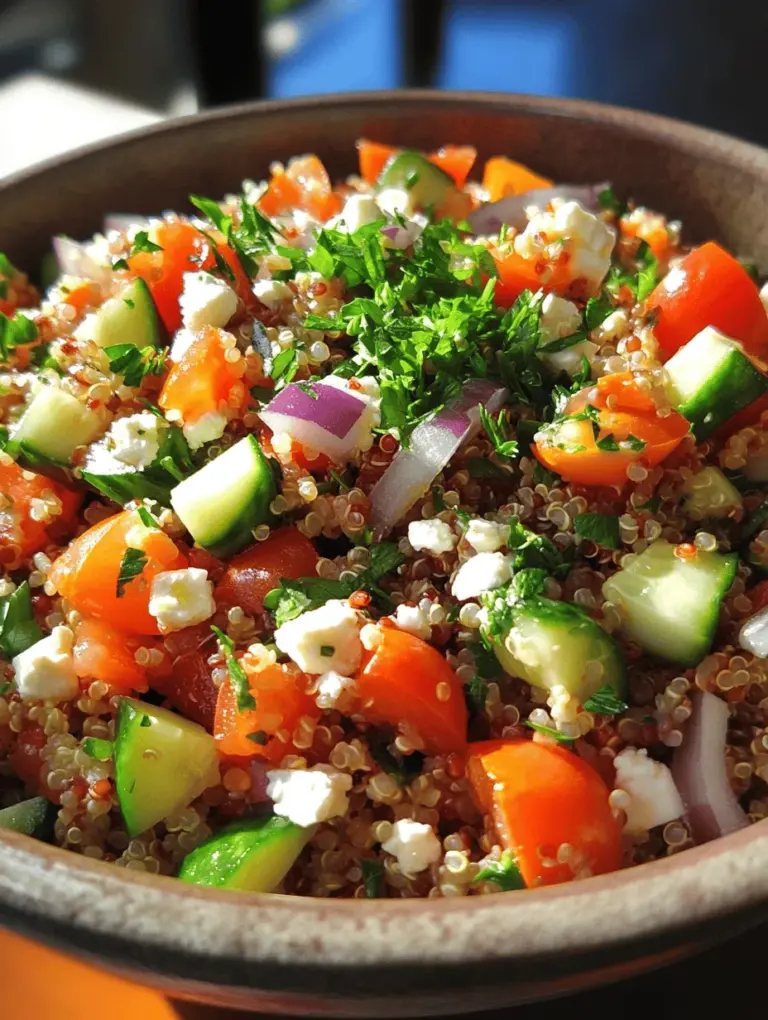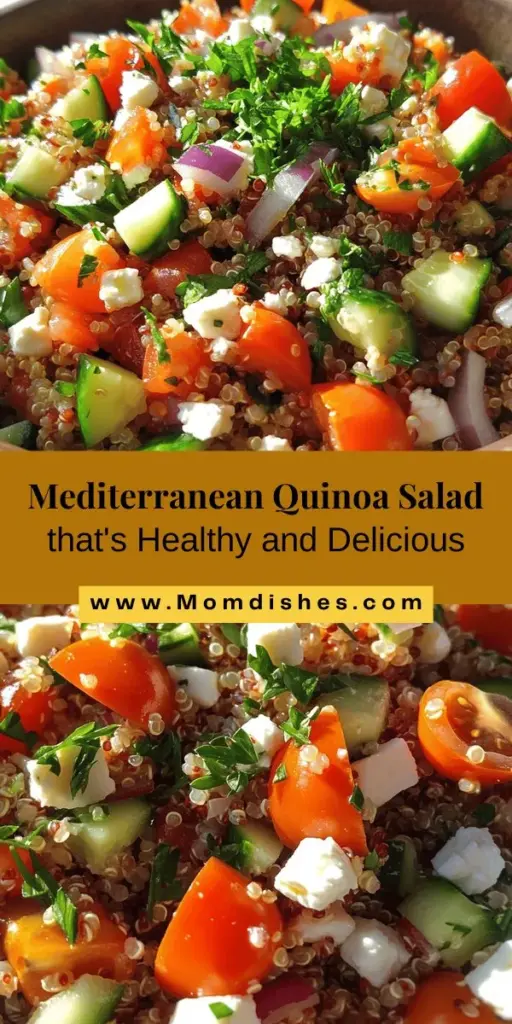Introduction to Mediterranean Quinoa Salad
The Mediterranean diet has gained enormous popularity for its numerous health benefits, emphasizing whole foods, healthy fats, and a bountiful array of fruits and vegetables. This eating pattern is not just a diet but a lifestyle choice that promotes longevity, heart health, and improved metabolic function. Rooted in traditional culinary practices from countries bordering the Mediterranean Sea, this diet highlights the benefits of consuming nutrient-rich foods such as lean proteins, healthy fats, and whole grains.
One standout ingredient in this vibrant culinary tradition is quinoa, a highly nutritious pseudo-grain packed with protein, fiber, vitamins, and minerals. Often hailed as a superfood, quinoa has captured the attention of health enthusiasts and chefs alike. Its versatility allows it to be incorporated into various dishes, making it a staple in many kitchens.
In this article, we will explore the delicious Mediterranean Quinoa Salad, a perfect embodiment of the Mediterranean diet. This salad is a colorful, flavorful, and healthy dish that can be enjoyed as a main course or a side dish for any occasion. It combines the nutty flavor of quinoa with fresh vegetables, tangy feta cheese, and Kalamata olives, creating a satisfying and wholesome meal that nourishes both the body and the soul.
Understanding the Ingredients
The Role of Quinoa in the Dish
At the heart of our Mediterranean Quinoa Salad lies quinoa, a remarkable ingredient that is both nutritious and versatile. Unlike many grains, quinoa is a complete protein, meaning it contains all nine essential amino acids necessary for human health. This makes it an excellent choice for vegetarians and vegans, providing a substantial protein source without animal byproducts.
Additionally, quinoa is rich in fiber, aiding digestion and promoting a sense of fullness, which can be beneficial for weight management. It also boasts an impressive nutrient profile, including vital vitamins and minerals such as magnesium, iron, B vitamins, and antioxidants. There are several types of quinoa, including white, red, and black varieties, each offering unique flavors and textures. While white quinoa is the most commonly used due to its mild taste and fluffy texture, red and black quinoa add a delightful crunch and visual appeal to salads.
Fresh Vegetables: Enhancing Flavor and Nutrition
Fresh vegetables are the stars of any Mediterranean salad, contributing essential nutrients and vibrant colors. In our Mediterranean Quinoa Salad, we will feature a medley of fresh vegetables that not only enhance the dish’s flavor but also provide a wealth of health benefits.
Cherry Tomatoes
Cherry tomatoes are a staple of Mediterranean cuisine, bursting with sweetness and juiciness. They are rich in antioxidants, particularly lycopene, which has been linked to a reduced risk of chronic diseases. Additionally, these little gems are an excellent source of vitamins C and K, essential for skin health and bone density.
Cucumber
Cucumbers are another refreshing component of this salad. Low in calories and high in water content, cucumbers are perfect for hydration. They are also a good source of vitamin K and contain antioxidants that contribute to overall health. Their crisp texture adds a delightful crunch, balancing the creaminess of feta cheese.
Red Bell Pepper
Red bell peppers provide a sweet and slightly tangy flavor, as well as a vibrant pop of color. They are high in vitamins A and C, which are crucial for maintaining healthy vision and boosting the immune system. Red bell peppers also contain a variety of phytonutrients that promote overall well-being.
Red Onion
Red onions add a sharp, zesty flavor to the salad, complementing the sweetness of the tomatoes and bell peppers. They are a good source of antioxidants and sulfur compounds, which may help lower blood pressure and reduce inflammation. Their vibrant color also enhances the visual appeal of the dish.
The Significance of Kalamata Olives and Feta Cheese
No Mediterranean salad would be complete without the inclusion of Kalamata olives and feta cheese.
Kalamata olives are renowned for their rich, briny flavor, which adds depth to the salad. These olives are also a great source of healthy monounsaturated fats, which can help lower bad cholesterol levels. Rich in antioxidants, Kalamata olives support heart health and contribute to a well-rounded diet.
Feta cheese, a crumbly and tangy cheese made from sheep’s or goat’s milk, adds creaminess and a bold flavor to the salad. It is lower in fat compared to many other cheeses, making it a healthier option while still providing a source of calcium and protein. Feta cheese also contains beneficial probiotics, promoting gut health.
The Role of Fresh Herbs: Parsley and Mint
Fresh herbs play an essential role in Mediterranean cuisine, adding layers of flavor and aroma to dishes. In our Mediterranean Quinoa Salad, we will incorporate parsley and mint, both of which bring brightness and freshness to the mix.
Parsley
Parsley is a nutrient-dense herb that is often overlooked. Packed with vitamins A, C, and K, parsley not only enhances the taste of the salad but also contributes to various health benefits, such as improved digestion and immune function. Its slightly peppery flavor complements the other ingredients beautifully, making it an essential addition to our salad.
Mint
Mint brings a refreshing and cooling flavor that elevates the overall taste of the dish. This herb is known for its soothing properties, aiding digestion and reducing inflammation. Mint also adds a delightful aromatic quality, making every bite of the salad a fragrant experience.
Lemon Juice and Olive Oil: The Dressing
To tie all the ingredients together, we will create a simple yet flavorful dressing using lemon juice and extra virgin olive oil.
Extra virgin olive oil is a fundamental component of the Mediterranean diet, known for its heart-healthy monounsaturated fats and antioxidant properties. It has been linked to numerous health benefits, including reduced risk of heart disease and improved brain function. The richness of olive oil balances the acidity of the lemon juice, creating a harmonious dressing that enhances the salad’s flavors while keeping it light and refreshing.
Lemon juice, with its bright, tangy flavor, adds acidity that helps to awaken the palate. It also provides a boost of vitamin C, promoting immune health and acting as a powerful antioxidant. Together, the combination of lemon juice and olive oil creates a delicious dressing that perfectly complements the ingredients of our Mediterranean Quinoa Salad.
Preparing the Mediterranean Quinoa Salad
Now that we’ve explored the ingredients and their health benefits, it’s time to dive into the preparation of our Mediterranean Quinoa Salad. Follow these step-by-step instructions to create a delicious and nutritious dish that will impress your family and friends.
Step-by-Step Guide to Cooking Quinoa Perfectly
1. Rinse the Quinoa: Begin by rinsing the quinoa under cold running water. This step is essential as it removes the natural coating called saponin, which can impart a bitter taste. Rinse until the water runs clear, ensuring a great flavor in your final dish.
2. Cooking Methods: You can cook quinoa using either water or vegetable broth for added flavor. The general ratio is 1 cup of quinoa to 2 cups of liquid. Using broth will enhance the taste, making your salad even more delicious.
3. Bring to a Boil: In a medium saucepan, combine the rinsed quinoa and your chosen liquid. Bring it to a boil over medium-high heat.
4. Simmer: Once boiling, reduce the heat to low, cover the saucepan, and let it simmer for about 15 minutes or until the quinoa has absorbed the liquid and is fluffy.
5. Fluff and Cool: Once cooked, remove the quinoa from heat and let it sit covered for an additional 5 minutes. Then, fluff it with a fork to separate the grains. Allow it to cool to room temperature before adding it to the salad.
Preparing the Vegetables
While the quinoa is cooking, you can prepare the fresh vegetables that will make your salad vibrant and nutritious.
1. Chopping Tips: For uniformity in texture and size, chop the vegetables into small, bite-sized pieces. This ensures that every bite of the salad is a perfect blend of flavors and ingredients.
2. Choosing Fresh Vegetables: When selecting vegetables, look for those that are firm, brightly colored, and free from blemishes. Fresh ingredients enhance the overall taste of the salad and contribute to its nutritional value.
3. Vegetable Prep:
– Cherry Tomatoes: Halve or quarter the cherry tomatoes, depending on your preference.
– Cucumber: Peel (if desired) and chop the cucumber into small cubes.
– Red Bell Pepper: Remove the seeds and membranes, then dice the red bell pepper into small pieces.
– Red Onion: Thinly slice or finely chop the red onion to add a zesty kick to the salad.
Combining Ingredients for Maximum Flavor
Once the quinoa has cooled and the vegetables have been prepared, it’s time to bring everything together:
1. Mixing the Base: In a large mixing bowl, combine the cooked quinoa, chopped vegetables, Kalamata olives, and feta cheese. Toss gently to mix all the ingredients without breaking the feta.
2. Adding Fresh Herbs: Finely chop the parsley and mint, and add them to the bowl. These fresh herbs will uplift the entire dish, infusing it with aromatic flavors.
3. Dressing the Salad: Drizzle the lemon juice and extra virgin olive oil over the salad. Season with salt and pepper to taste. Gently toss the salad again to ensure that the dressing evenly coats all the ingredients.
4. Let It Rest: Allow the salad to sit for about 15 minutes before serving. This resting period lets the flavors meld together, making each bite even more delicious.
By following these steps, you’ll create a Mediterranean Quinoa Salad that is not only visually stunning but also packed with nutrients and flavors. This dish embodies the essence of the Mediterranean diet, making it a perfect addition to your culinary repertoire. Enjoy the vibrant colors and fresh tastes, and feel good knowing you’re nourishing your body with wholesome ingredients. Whether served at a summer barbecue, a family gathering, or as a meal prep option for busy weekdays, this Mediterranean Quinoa Salad is guaranteed to be a hit!
{{image_1}}
Best Practices for Mixing Quinoa and Vegetables
Mixing quinoa and vegetables might seem straightforward, but achieving the perfect blend requires attention to detail. Start by ensuring your quinoa is fully cooked and fluffy; this will prevent clumping and allow it to mix seamlessly with the vegetables. After cooking, let it cool slightly to avoid wilting the fresh ingredients.
When combining the quinoa with vegetables, use a large mixing bowl to create ample space for tossing. Gently fold the quinoa into the mixed vegetables rather than stirring vigorously; this helps maintain the integrity of the vegetables while evenly distributing the quinoa. For an even distribution, layer your ingredients, starting with the quinoa at the bottom, followed by the chopped vegetables. This way, you can use a spatula to lift from the bottom while folding so that each bite is balanced with grains and greens.
Techniques for Ensuring Even Distribution of Dressing
The dressing is a crucial component that ties the salad together, enhancing flavors and texture. To ensure an even distribution, it’s essential to apply the dressing in a controlled manner. Start by drizzling a small amount over the salad and gently toss using a folding technique. This incorporates the dressing without bruising the vegetables.
If you find that some parts are drier than others, add more dressing gradually, tossing again until you achieve a uniform coating. Remember to taste as you go; this allows you to adjust the acidity or sweetness of the dressing according to your preference.
Flavor Building: The Dressing
Importance of the Dressing in Mediterranean Cuisine
In Mediterranean cuisine, dressing serves as a vital flavor enhancer, elevating simple ingredients into a harmonious dish. A well-crafted dressing not only adds zest but also brings out the natural flavors of the salad components.
How the Dressing Enhances the Salad’s Overall Flavor
The right dressing can transform a basic salad into a culinary delight. It melds the flavors of the quinoa and vegetables, creating a cohesive taste experience. The acidity from vinegar or citrus cuts through the richness of the oil, while herbs and spices add depth.
Detailed Breakdown of the Dressing Ingredients
For our Mediterranean Quinoa Salad, the dressing consists of olive oil, red wine vinegar, fresh lemon juice, minced garlic, dried oregano, salt, and pepper.
– Olive Oil: Rich in healthy fats, it adds a creamy texture.
– Red Wine Vinegar: Provides acidity, balancing the oil’s richness.
– Fresh Lemon Juice: Brightens the flavor.
– Minced Garlic: Adds a punch of flavor and aroma.
– Dried Oregano: A classic Mediterranean herb, contributing earthiness.
– Salt and Pepper: Essential for seasoning, enhancing the other flavors.
The Balance of Acidity and Fat
The balance of acidity and fat in your dressing is crucial. The olive oil should complement the acidity from both the vinegar and lemon juice. A good rule of thumb is to maintain a 3:1 ratio of oil to vinegar/citrus. This balance ensures the dressing is flavorful but not overwhelmingly acidic.
Adjusting Flavors: Salt, Pepper, and Lemon Juice
Taste your dressing as you mix to adjust the flavors to your liking. If it feels too sharp, add a bit more olive oil. If it lacks brightness, a little more lemon juice can elevate it. Salt enhances the overall flavor, but be cautious as it can easily overpower.
Techniques for Whisking and Emulsifying the Dressing
For a perfectly emulsified dressing, whisking is key. Start by combining the vinegar, lemon juice, garlic, oregano, salt, and pepper in a bowl. Gradually stream in the olive oil while whisking vigorously. This technique helps create a smooth emulsion, ensuring that the oil does not separate from the other ingredients.
Serving Suggestions and Variations
Best Practices for Chilling the Salad
Chilling your Mediterranean Quinoa Salad before serving allows the flavors to meld beautifully. After mixing the salad, cover it with plastic wrap or store it in an airtight container in the refrigerator for at least 30 minutes. This time allows the dressing to penetrate the ingredients, enhancing the overall flavor.
Importance of Chilling for Flavor Melding
The chilling process not only melds flavors but also improves the texture of the salad. The cold temperature can accentuate the freshness of the vegetables and makes for a refreshing dish, especially in warmer months.
Serving Suggestions
This salad can be served as a light lunch, a side dish at barbecues, or as part of a Mediterranean-themed dinner. For an upscale presentation, serve the salad in individual bowls or plates, garnishing with extra herbs or a sprinkle of feta cheese for added color and flavor.
Ideal Occasions for Serving Mediterranean Quinoa Salad
The Mediterranean Quinoa Salad is perfect for various occasions. Whether you’re hosting a summer barbecue, preparing a family dinner, or looking for a healthy lunch option, this salad is versatile enough to fit any meal. It also makes a great dish for potlucks or picnics, as it can be made ahead and served cold.
How to Present the Salad Attractively
Presentation can elevate your dish significantly. Consider layering the salad ingredients in a clear glass bowl to showcase the vibrant colors of each component. Garnish with fresh herbs like parsley or basil, and a sprinkle of lemon zest to add an aromatic touch.
Variations and Substitutions
The beauty of the Mediterranean Quinoa Salad lies in its adaptability. Here are some suggestions for variations and substitutions:
– Alternative Vegetables: Incorporate seasonal vegetables like bell peppers, zucchini, or roasted eggplant.
– Proteins: For added protein, consider mixing in canned chickpeas, grilled chicken, or shrimp.
– Dairy-Free Options: If you prefer a dairy-free version, omit the feta cheese or replace it with a vegan cheese alternative.
Nutritional Information and Health Benefits
Nutritional Breakdown of the Mediterranean Quinoa Salad
A typical serving of Mediterranean Quinoa Salad contains approximately:
– Calories: 250-300
– Carbohydrates: 40g
– Protein: 10g
– Fat: 10g
This nutritional profile makes it a balanced meal option suitable for various dietary needs.
Caloric Content and Macronutrient Distribution
The quinoa provides complex carbohydrates, while the olive oil contributes healthy fats. The addition of vegetables increases the fiber content, promoting satiety and digestive health.
Health Benefits Associated with the Salad’s Ingredients
The Mediterranean Quinoa Salad is packed with health benefits.
– Heart Health: Ingredients like olive oil and vegetables are known to support cardiovascular health.
– Weight Management: High in fiber and protein, it keeps you full longer, aiding in weight management.
– Anti-inflammatory Properties: Many components of this salad, such as olive oil and fresh herbs, have anti-inflammatory effects, contributing to overall well-being.
The Role of Mediterranean Diets in Long-Term Health and Wellness
The Mediterranean diet is renowned for its health benefits, including reduced risks of chronic diseases. Rich in fruits, vegetables, whole grains, and healthy fats, it promotes a balanced lifestyle and encourages the consumption of fresh, unprocessed foods.
Conclusion: Embracing Healthy Eating with Mediterranean Quinoa Salad
In summary, the Mediterranean Quinoa Salad is not only a delicious and versatile dish but also a powerhouse of nutrition. Its combination of fresh vegetables, protein-rich quinoa, and a flavorful dressing makes it an ideal choice for anyone looking to embrace healthy eating. As you incorporate more Mediterranean-inspired dishes into your diet, you’ll find that they provide both satisfaction and numerous health benefits.
Don’t hesitate to experiment with different ingredients and flavors to make this salad your own. The key takeaway is to prioritize fresh, healthy ingredients, which will enhance both the taste and nutritional profile of your meals. Enjoy the journey of exploring Mediterranean cuisine and its myriad of vibrant, healthful options!


